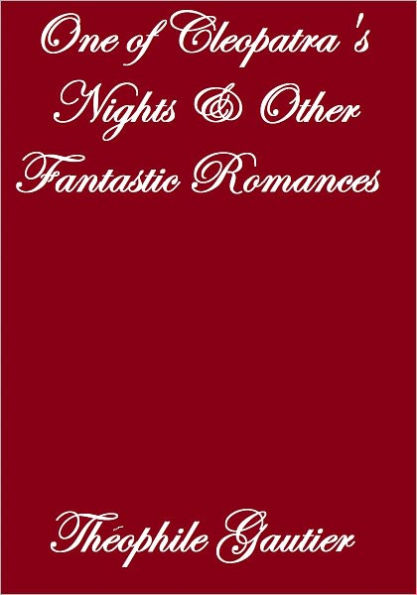TO THE READER
The stories composing this volume have been selected for translation
from the two volumes of romances and tales by Théophile Gautier
respectively entitled _Nouvelles_ and _Romans et Contes_. They afford in
the original many excellent examples of that peculiar beauty of fancy
and power of painting with words which made Gautier the most brilliant
literary artist of his time. No doubt their warmth of coloring has been
impoverished and their fantastic enchantment weakened by the process of
transformation into a less voluptuous tongue; yet enough of the original
charm remains, we trust, to convey a just idea of the French author's
rich imaginative power and ornate luxuriance of style.
The verses of Swinburne referring to the witchery of the novelette which
opens the volume, and to the peculiarly sweet and strange romance which
follows, sufficiently indicate the extraordinary art of these tales. At
least three of the stories we have attempted to translate rank among the
most remarkable literary productions of the century.
These little romances are characterized, however, by merits other than
those of mere literary workmanship; they are further remarkable for a
wealth of erudition--picturesque learning, we might say--which often
lends them an actual archæologic value, like the paintings of some
scholarly artist, some Alma Tadema, who with fair magic of
color-blending evokes for us eidolons of ages vanished and civilizations
passed away.
Thus one finds in the delightful fantasy of _Arria Marcella_ not only a
dream of "Pompeiian Days," pictured with an idealistic brilliancy beyond
the art of Coomans, but a rich knowledge, likewise, of all that
fascinating lore gleaned by antiquarian research amid the ashes of the
sepultured city--a knowledge enriched in no small degree by local study,
and presented with a descriptive power finely strengthened by personal
observation. It is something more than the charming imagination of a
poetic dreamer which paints for us the blue sea "unrolling its long
volutes of foam" upon a beach as black and smooth as sifted charcoal;
the fissured summit of Vesuvius, out-pouring white threads of smoke from
its crannies "as from the orifices of a perfuming pan;" and the
far-purple hills "with outlines voluptuously undulating, like the hips
of a woman."
And throughout these romances one finds the same evidences of
archæologic study, of artistic observation, of imagination fostered by
picturesque fact. The glory of the Greek kings of Lydia glows goldenly
again in the pages of _Le Roi Candaule_; the massive gloom and
melancholy weirdness of ancient Egypt is reflected as in a necromancer's
mirror throughout _Une Nuit de Cléopâtre_. It is in the Egyptian
fantasies, perhaps, that the author's peculiar descriptive skill appears
to most advantage; the still fresh hues of the hierophantic paintings,
the pictured sarcophagi, and the mummy-gilding seem to meet the reader's
eye with the gratification of their bright contrasts; a faint perfume
of unknown balm seems to hover over the open pages; and mysterious
sphinxes appear to look on "with that undefinable rose-granite smile
that mocks our modern wisdom."
Excepting _Omphale_ and _La Morte Amoureuse,_ the stories selected for
translation are mostly antique in composition and coloring; the former
being Louis-Quinze, the latter mediæval rather than aught else. But all
alike frame some exquisite delineation of young love-fancies; some
admirable picture of what Gautier in the _Histoire du Romantisme_ has
prettily termed "the graceful _succubi_ that haunt the happy slumbers of
youth."
And what dreamful student of the Beautiful has not been once enamoured
of an Arria Marcella, and worshipped on the altar of his heart those
ancient gods "who loved life and youth and beauty and pleasure"? How
many a lover of mediæval legend has in fancy gladly bartered the blood
of his veins for some phantom Clarimonde? What true artist has not at
some time been haunted by the image of a Nyssia, fairer than all
daughters of men, lovelier than all fantasies realized in stone--a
Pygmalion-wrought marble transmuted by divine alchemy to a being of
opalescent flesh and ichor-throbbing veins?



